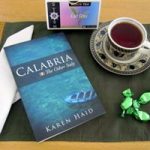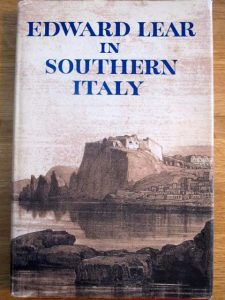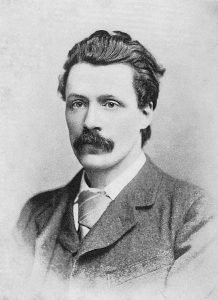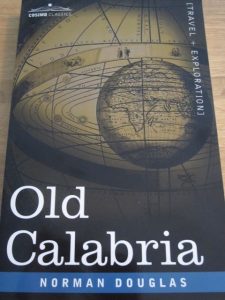CALABRIAN TRAVELOGUES
If you do any search of books about Calabria, there are three titles that will invariably come up: Journals of a Landscape Painter in Southern Calabria (1852) by Edward Lear, By the Ionian Sea: Notes of a Ramble in Southern Italy (1901) by George Gissing and Old Calabria (1915) by Norman Douglas.
At first, you sort of scratch your head. I counted eleven different new paperbacks and electronic versions of Douglas’ book currently available on Amazon, nine for Gissing, and six for Lear. That’s a lot of buzz for old books about a little-known Italian region.
Who’s reading these books? What insights could these travelogues of 100+ years offer the reader today? Hasn’t Calabria changed?
Well, apparently quite a few people must still be reading these books or so many different publishers wouldn’t be bothering with them. (Public domain also plays its part with these multiple editions.) In any case, I, for one, have read these Calabrian travelogues and I know quite a few others who have too. One of the reasons they’re so widely read is that there haven’t been that many books written in English about Calabria.
If you search for a book on Tuscany, Venice or Rome, you have an enormous choice in all sorts of categories. The page list for Calabrian travelogues and other books on the region, however, peters out pretty quickly. Thus said, if these old treatises weren’t worthy, they wouldn’t have lasted so many years. And that’s just it—this trio of classic books still has value for today’s reader: literarily, historically and in the case of Lear, even artistically.
CLASSIC BRITISH TRAVEL WRITING
When approaching these works, an aspect that must be kept in mind is that the writers were from a different era, from a time that wasn’t concerned with our contemporary notions of political correctness. These particular authors were products of middle and upper class British upbringings, and they were writing for an audience with the same background and Anglo view of the world.
At the opening of his The Kingdom by the Sea, the renowned American travel writer and novelist Paul Theroux addresses this very issue, summing up the traditional British approach to travel writing as follows:
The British had invented their own solution to travel-writing. They went to places like Gabon and Paraguay and joked about the discomforts, the natives, the weather, the food, the entertainments. It was necessary to be an outsider, which was why they had never written about Britain in this way. But it was a mystery to me why no one had ever come to Britain and written about its discomforts and natives and entertainments and unintelligible dialects. The British, who had devised a kind of envious mockery of other cultures, and who had virtually invented the concept of funny foreigners, had never regarded themselves as fair game for the travel-writer. They did not encourage aliens to observe them closely. They were like a tribe that plundered abroad and were secretive and inhospitable at home. The British did not make me think of Shakespeare but rather of head-hunters – their travel-writing a literary version of head-shrinking that had never been used on them. I was eager to try.
Paul Theroux, The Kingdom by the Sea (Houghton Mifflin Company, Boston, 1983, p. 4)
I wouldn’t place this trio of classic Calabrian travel-writers into the headhunter category although their books were crafted from a distinctly British point of view. They reported their versions of what they saw, and they didn’t do so lightly. Their trips to Calabria weren’t whimsical jaunts. They all spoke Italian, and Lear and Douglas often traveled great distances by foot. They were adventurous individuals who had ventured off the comfortable path of the Grand Tour.
JOURNALS OF A LANDSCAPE PAINTER IN SOUTHERN CALABRIA
Edward Lear (1812-1888) was a British artist and writer, best known for his popularization of the limerick or what he referred to as “nonsense verse.” He visited Calabria in 1847, traveling in the Province of Reggio Calabria from July to September. Although he had plans to see more of the region, he had to cut his trip short due to a local uprising against Bourbon rule.
As to be expected from a writer with a penchant for verbal invention, his journals are chock full of colorful descriptions of both the landscape and its inhabitants. Writing in the preface to a 1964 edition (William Kimber, London, p. 9), Peter Quennell affirms that, “Lear had the painter’s trained eye…. (He) uses his pen as if it were a pencil or a brush… He is often poetic, but he is always delightfully exact, at a time when artistic exactitude was more highly valued than it is today.”
His drawings are equally meticulous, luring viewers into his 19th-century romantic world. The journal includes sixteen lithograph prints of Calabrian landscapes and four from more northerly regions of the Kingdom of Naples to accompany the section on Naples, Basilicata and Apulia. The book was originally published as Journals of a Landscape Painter in Southern Calabria, etc.
BY THE IONIAN SEA: NOTES OF A RAMBLE IN SOUTHERN ITALY
George Gissing (1857-1903) was an English novelist who traveled to Calabria in 1897 despite the strong cautions he received in Naples as he was preparing to set off for his journey southward. He writes of these Neapolitans at the opening of By the Ionian Sea:
Both are astonished at my eccentricity and hardiness in undertaking a solitary journey through the wild South. Their geographical notions are vague; they have barely heard of Cosenza or of Cotrone, and of Paola not at all; it would as soon occur to them to set out for Morocco as for Calabria. How shall I get along with people whose language is a barbarous dialect? Am I aware that the country is in great part pestilential?
George Gissing, By the Ionian Sea (Project Gutenberg Ebook#4354, 2009)
Gissing was not deterred, however, from his quest for the classical past. Landing by boat in Paola on the Tyrrhenian or western coast, visiting Cosenza, then taking the train to Taranto in Apulia and traveling the Ionian or eastern coast into Calabria and ending in Reggio, he experiences the region’s historical legacy along with the discomforts of travel in the rural south. Gissing candidly describes the poor peasantry and corrupt officials, he laments of less than adequate accommodations, but he also genuinely appreciates and often admires the spirit of the Calabrian people.
OLD CALABRIA
Norman Douglas (1868-1952) was a British writer who spent many years of his life in Italy. Although he may be best remembered for the novel South Wind, he published a number of travel books, three about his journeys on foot in Italy.
With the title Old Calabria, Douglas uses an historical reference to the area that would today correspond to the regions of Apulia, Basilicata and Calabria. The book is the fruit of many visits, the first in 1907 and the longest in 1911. He tours this land with the pace of a bygone era and wields his pen with the erudite intensity of yesteryear as well:
This corner of Magna Graecia is a severely parsimonious manifestation of nature. Rocks and waters! But these rocks and waters are actualities; the stuff whereof man is made. A landscape so luminous, so resolutely scornful of accessories, hints at brave and simple forms of expression; it brings us to the ground, where we belong; it medicines to the disease of introspection and stimulates a capacity which we are in danger of unlearning amid our morbid hyperborean gloom – the capacity for honest contempt: contempt of that scarecrow of a theory which would have us neglect what is earthly, tangible. What is life well lived but a blithe discarding of primordial husks, of those comfortable intangibilities that lurk about us, waiting for our weak moments?
Norman Douglas, Old Calabria (Harcourt, Brace & Co., New York, 1956, p. 338)
 For a window on contemporary Calabria and South Italy, browse through My Italian Blog and check out my award-winning Calabrian travelogue Calabria: The Other Italy, a nonfiction book based on my 4 years of living, working and traveling throughout this fascinating southern Italian region. The book explores daily life, culture, history, the arts, food, society and tourism of Calabria, Italy, and it’s available in paperback and e-book formats.
For a window on contemporary Calabria and South Italy, browse through My Italian Blog and check out my award-winning Calabrian travelogue Calabria: The Other Italy, a nonfiction book based on my 4 years of living, working and traveling throughout this fascinating southern Italian region. The book explores daily life, culture, history, the arts, food, society and tourism of Calabria, Italy, and it’s available in paperback and e-book formats.
Visit Calabria: The Other Italy’s Facebook page, Karen’s Instagram and Karen’s Twitter for more beautiful pictures and information.
Sign up below to receive the next blog post for free directly to your email.




Comments 2
Thanks for this round up, it’s helped me choose one for my partner’s birthday. I was getting confused, but you have successfully un confused me!
Author
Glad to assist, but in any case, you can’t go wrong with a classic!